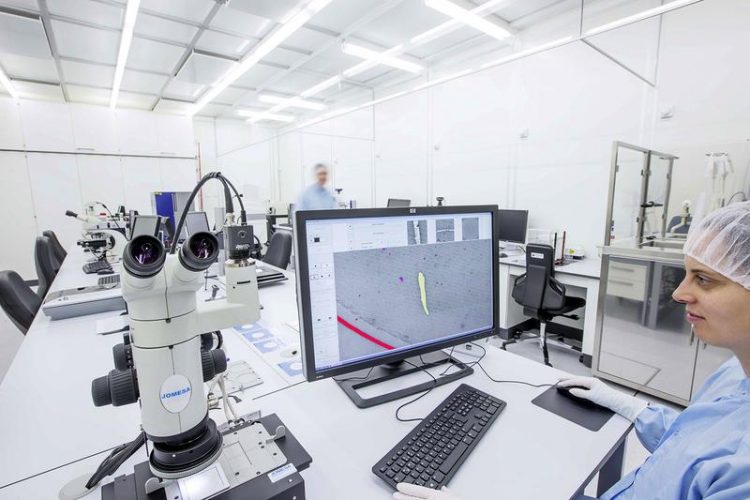New VDI standards established for cleanroom technology

Fraunhofer IPA helps to shape different regulations for cleanroom technology. The experts will present important new developments at the Cleanzone and Lounges on Tour trade fairs. ISS DEBEOS Studios
Dr. Udo Gommel, Head of the Department of Ultraclean Technology and Micromanufacturing, is responsible for the establishment of cleanroom and cleanliness technology regulations on several committees and in industry networks. He is Chairman of the VDI Expert Committee on Cleanroom Technology, which is made up mostly of industry representatives, and meets with the committee at least twice a year in order to examine over 20 guidelines on cleanroom technology (VDI 2083), modify them where appropriate and align them with the international ISO equivalents.
Basic standard for nanoscale particle contamination expanded
At previous meetings, the VDI Expert Committee on Cleanroom Technology determined the need for cleanrooms and cleanliness-technology-controlled areas to expand into ranges below 0.1 micrometers into the single-digit nanoscale range. The reason for this is that line widths are becoming ever smaller in the semiconductor and nanotechnology sectors.
“Smaller and smaller components are required to produce microchips. Consequently, the size at which particle contamination must be controlled is also decreasing”, Dr. Gommel explains. VDI 2083/1, which the experts refer to as the “mothership” of VDI standards on cleanroom technology, covers particle sizes of 0.1 to 5.0 micrometers. The new forthcoming standard VDI 2081/1.1 relates to much smaller contaminants in the range of 5-100 nanometers.
The VDI Expert Committee created a new classification system for this that specifies threshold values for compliance with product and process-specific specifications. Measuring techniques and procedures for characterizing clean areas and equipment were also determined. The new guidelines are to be adopted at the end of this year. Dr. Gommel will present the new developments in his lectures at Cleanzone and Lounges on Tour on October 18.
New calculation method determines the desorption time of H2O2
Another subject that the VDI Expert Committee on Cleanroom Technology took on is desorption kinetics, more specifically the degradation of hydrogen peroxide (H2O2) after applying it to surfaces in cleanliness-technology-controlled areas. To ensure that there is no contamination of pharmaceutical or medical technology products and surfaces where cleanliness is critical, for example in manufacturing tablets or implants, cleanrooms must be sterilized overnight.
This is often done by hydrogen peroxide fogging, which kills off microorganisms. However, increased concentrations of H2O2 are harmful to humans and should not be inhaled, so cleanrooms are ventilated after sterilization until the H2O2 level has decreased to a non-critical value. In spite of this, the gas adheres to surfaces, meaning that degradation slows down and this delays the resumption of production activities in the cleanroom.
For this reason, Fraunhofer IPA developed a procedure that can be used to determine the half-life of H2O2 degradation. Dr. Gommel: “This means that users know when they can resume production.” The new calculation algorithm was integrated into VDI guideline 2083/20. On October 18, Fraunhofer IPA expert Dr. Markus Keller will present the procedure to the public at Cleanzone.
From pure ambient air assessment to specific contaminants
Fraunhofer IPA also works with committees and industry networks to harmonize the various guidelines on cleanroom and cleanliness technology. In addition to the VDI 2083 set of guidelines, the international set of standards ISO 14644 and the European Cooperation for Space Standardization (ECSS) for the aviation and aerospace sectors also apply to cleanroom workers. For airborne contaminants, a trend can be seen: cleanroom environments are no longer just being assessed as a means to an end, with the products and their specific cleanliness requirements becoming ever more important.
Dr. Gommel: “Previously, standards only focused on air purity, whereas now users can receive concrete guidelines on the requirements for surface cleanliness, component specifications or production environment qualities. This applies to particulate, chemical, film-type and microbiological aspects that are required for production processes, such as for manufacturing satellites, car components or even implants.” Dr. Gommel will explain this topic in more detail at Lounges on Tour on 18 October.
Details of lectures
1. Cleanzone
When: October 17-18, 2017
Where: Frankfurt am Main, Messe Frankfurt
Lectures:
9:15am to 9:40am: »VDI 2083/1.1 Nanoscale contamination – classification and measurement« (Speaker: Dr. Udo Gommel, Fraunhofer IPA)
10:15am to 10:40am: »VDI 2083/20 Determining the desorption kinetics of substances after fogging« (Speaker: Dr. Markus Keller, Fraunhofer IPA)
2. Lounges on Tour:
When: October 17-18, 2017
Where: Frankfurt am Main, The Squaire, Frankfurt Airport
Lecture:
11:30am to 12:00pm: »Development of standards (ISO, VDI, ECSS) – ACC influence on product environment and process suitability of consumables« (Speaker: Dr. Udo Gommel, Fraunhofer IPA)
Press communication
Ramona Hönl | Telefon +49 711 970-1638 | ramona.hoenl@ipa.fraunhofer.de
Expert contact
Dr. Udo Gommel | Telefon +49 711 970-1633 | udo.gommel@ipa.fraunhofer.de
http://www.cleanzone.messefrankfurt.com/frankfurt/en/besucher/willkommen.html?nc
Media Contact
More Information:
http://www.ipa.fraunhofer.de/All latest news from the category: Trade Fair News
Newest articles

Innovative 3D printed scaffolds offer new hope for bone healing
Researchers at the Institute for Bioengineering of Catalonia have developed novel 3D printed PLA-CaP scaffolds that promote blood vessel formation, ensuring better healing and regeneration of bone tissue. Bone is…

The surprising role of gut infection in Alzheimer’s disease
ASU- and Banner Alzheimer’s Institute-led study implicates link between a common virus and the disease, which travels from the gut to the brain and may be a target for antiviral…

Molecular gardening: New enzymes discovered for protein modification pruning
How deubiquitinases USP53 and USP54 cleave long polyubiquitin chains and how the former is linked to liver disease in children. Deubiquitinases (DUBs) are enzymes used by cells to trim protein…



